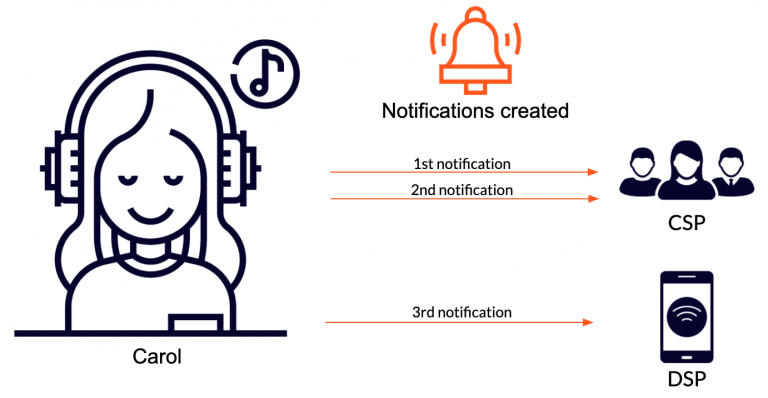In case you missed it, in Part 1 to this post, we started to explore an iov42 approach to leveraging blockchain technology in the music industry, which is known to be fraught with extremely complex supply chains and copyright ownership structures. In Part 1, we explained how a song could be registered on the iov42 platform.
In Part 2, we will go on to outline what happens when the registered song is played via a music streaming app.
Phase 2: Tracking plays of Beispiel-Lied by Alice featuring Bob (i.e. Beispiel-Lied: Recording A)
Now the story turns to our end user, Carol, who listens to most of her music through a streaming app (i.e. a DSP). This DSP has been granted access by the CSP to play Beispiel-Lied through a mechanical licensing agreement.
When Carol streams Beispiel-Lied: Recording A, three notifications are automatically generated. Two are transferred to the CSP: one to catalog a play of Clive’s Beispiel-Leid; one to catalog a play of Alice and Bob’s Recording A. The last notification is for the DSP to keep track of its streaming metadata.

All of these play counts are stored within an integrated, blockchain-based ecosystem.
With play counts being stored immutably and almost instantaneously, all stakeholders in the supply chain will be able to know, authenticate, and audit the following information:
Having this data eliminates redundancies in the supply chain, elucidates copyright ownership splits, and captures song metadata that is often lost at the expense of the creatives.
After a given time, the CSP would oversee the payout of royalties to Clive, Alice, and Bob in accordance with the number of times Beispiel-Lied is played and the copyright ownership splits. The DSP, in turn, can verify that the CSP’s records of how often a song was played matches its own records, when necessary. This phase of the music rights journey isn’t included in our current example, as there are several other factors that would need to be considered and, subsequently, several different approaches that could be modelled. However, because this phase is important to developing a fully integrated blockchain-based solution for the music industry, it could be the subject of a future post.
iov42 is not the first to consider a blockchain-based solution for music rights and, as mentioned earlier, there are several different initiatives already being implemented. However, the iov42 platform has several unique features that make it particularly qualified to capture and track the copyright ownership rights of creatives in the music industry.
For instance, the platform’s approach to asset modelling and certification establishes clear copyright ownership, which facilitates secure, fully regulated and auditable digital value transfer, something that is still missing in the music industry.
Furthermore, our example employs the use of smart assets, which are programmed to behave in a certain way—in this case they inherently represent the copyright splits between the artists, thus providing an efficient solution to an otherwise complex problem.
Now that we have imagined one way blockchain technology can be leveraged to capture the ownership of music copyrights, we should briefly take stock of a few considerations specific to this example.
The story of our fictitious song, Beispiel-Lied, is an intentionally super-simplified example of music rights; attempting to represent a more complete picture of music copyrights and how they fit into bigger supply chains would have resulted in an unnecessarily long and complicated article. However, with the basic model of music rights ownership configured (as explained above), it becomes much easier to conceptualize how this model could be expanded to include, for example, contractual agreements between the CSP and the artists or the DSP, as well as a wider range of music-licensing models that exist within and beyond the music-streaming space.
Blockchain technology has just begun to tackle the monolithic music industry; as the technology continues to develop, hopefully the music industry will continue to see further advancements in supply chain streamlining and the fair, timely compensation of artists.
By submitting your email you consent to receive iov42 newsletters by email. You can unsubscribe at any time. For further information, please see our Terms and Conditions and Privacy Policy
